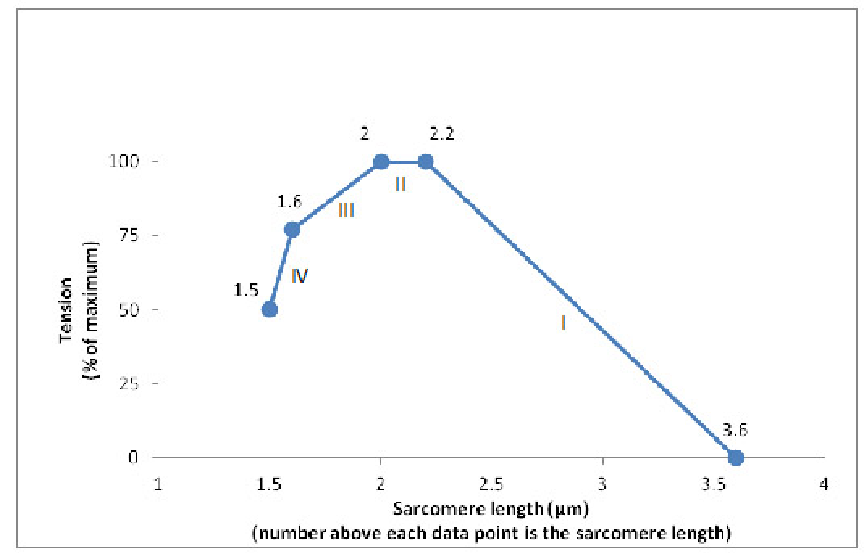The sliding filament model for muscle contraction can be studied using an isolated skeletal muscle that is fixed at each end, while a machine records the tension that is generated when the muscle is stimulated to contract. In one particular muscle tested, the length of the thick filaments was 1.6 mm and the length of the thin filaments that project in from each Z line towards the center of the sarcomere was 1.0 mm. A summary of the results comparing sarcomere length to the degree of tension produced during contraction is shown below. What most likely explains the difference between segment II and segment III of the graph?

A. The muscle cells used up all the ATP by the end of segment II.
B. The length of the thin filaments is decreasing in segment III but not in segment II.
C. There is an increasing overlap of the free ends of the thin filaments in segment III but not in segment II.
D. The length of the thick filaments is decreasing in segment III but not in segment II.
E. The distance between the Z lines is constant in segment II but rapidly increasing in segment III.
F. Fewer myosin cross-bridges are forming in segment II than in segment III.
Clarify Question
· What is the key concept addressed by the question?
· What type of thinking is required?
Gather Content
· What do you know about the correlation between sarcomere length and tension? What other information is related to the question?
Choose Answer
· Given what you now know, what information is most likely to produce the correct answer?
Reflect on Process
· Did your problem-solving process lead you to the correct answer? If not, where did the process break down or lead you astray? How can you revise your approach to produce a more desirable result?
C. There is an increasing overlap of the free ends of the thin filaments in segment III but not in segment II.
Clarify Question
· What is the key concept addressed by the question?
o The question asks about the correlation between sarcomere length and tension.
· What type of thinking is required?
o You are being asked to analyze statements about the correlation between sarcomere length and tension.
Gather Content
· What do you know about the correlation between sarcomere length and tension? What other information is related to the question?
o As the sarcomere contracts, the free ends of the thin filaments approach each other as seen in segment I. Once the ends reach each other, any further contraction in sarcomere length does not increase tension (section II). As the thin filaments overlap each other, fewer actin and myosin bridges are formed and the tension of the sarcomere decreases (segment III).
Choose Answer
· Given what you now know, what information is most likely to produce the correct answer?
o There is an increasing overlap of the free ends of the thin filaments in segment III but not in segment II.
Reflect on Process
· Did your problem-solving process lead you to the correct answer? If not, where did the process break down or lead you astray? How can you revise your approach to produce a more desirable result?
o This question asked you to analyze statements about the correlation between sarcomere length and tension. If you got the correct answer, great job! If you got an incorrect answer, where did the process break down? Did you think that the distance between Z lines in segment III are longer than in segment II? Did you think that the length of the thin filaments change during a contraction?
You might also like to view...
Polyandry is the mating system in which ____
a. one male and one female form a long-term association b. both males and females mate with multiple partners c. one male mates with many females d. one female mates with many males e. both males and females provide care to offspring
When an electrical impulse traveling along a motor neuron arrives at a neuromuscular junction
A) there is an increase in the secretion of acetylcholine at the neuromuscular junction. B) calcium is transported back to the sarcoplasmic reticulum. C) sliding of actin and myosin filaments is inhibited. D) myosin-actin cross-bridges are destroyed. E) a new electrical impulse is generated that returns the message to the original nerve.
Vascular cambium gives rise to which of the following tissues?
a. primary phloem b. periderm c. epidermis d. secondary xylem e. cork cambium
What is the best strategy for preserving biodiversity?
A) to depend on the Endangered Species Act to produce its intended consequences B) to prevent inbreeding in small populations C) to use genetic engineering to create new combinations of genes D) to prevent species from becoming endangered in the first place